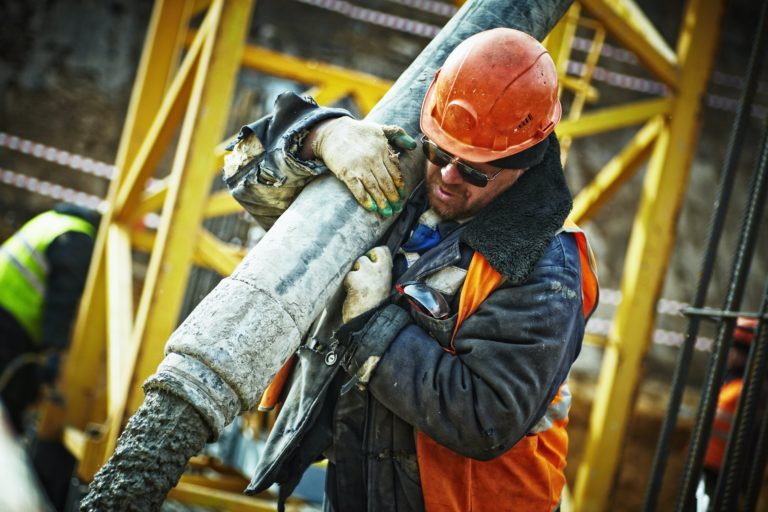One of the most important aspects of concrete strength development and ensuring the integrity of a completed structure is the temperature of the concrete pours during the early stages of construction. We are not always lucky enough to experience perfect conditions for concrete pouring and curing. If the temperature is consistently 60°F (15°C ), it’s likely that you won’t run into trouble, but what happens when you’re faced with more extreme weather conditions? In this blog, we will delve into what is needed when pouring concrete in winter and pouring concrete in summer, as well as the importance of monitoring temperature.


Download the full Checklist now and experience smoother, stress-free cold-weather concreting like never before.
Pouring Concrete in Winter

According to ACI 306: Guide to Cold Weather Concreting, “cold weather” is defined as three or more consecutive days of low temperatures, specifically outdoor temperatures below 40°F (4°C) and air temperature below 50°F (10°C) for more than any 12-hour period.
The water present in concrete causes it to harden through a chemical process called hydration. During this process, the chemicals in the concrete react with water to bind the mixture together.
The problem with cold weather is that it slows down this process or stops it completely, negatively impacting the strength gain of the concrete.
Furthermore, it’s critical for concrete to set before being exposed to freezing temperatures. If fresh concrete is exposed to freezing temperatures, the water in the concrete can freeze, causing it to crack and significantly reducing the concrete’s durability.
So, how do you ensure that concrete gains the appropriate strength and durability in winter? One way to do this is to avoid pouring concrete on frozen ground. The uneven setting will occur when the ground thaws which will cause cracking. If the ground is frozen, use heaters to thaw it before pouring your concrete. The temperature of the ground should be as close to that of the concrete as possible.
Additionally, if you need to raise the temperature of your concrete pours, there are several things you can do. Here are some simple techniques:
- Keep the concrete in a dry and heated area until it’s ready to use.
- Cover the concrete with a curing blanket.
- Add hot water to the concrete mix.
- Add more cement to the mix.
For more information, check out our blog: 7 Common Cold Weather Concreting Mistakes!
Pouring Concrete in Summer

While pouring concrete in summer when temperatures are high comes with a different set of considerations from pouring in winter, if you don’t carefully monitor concrete temperatures, the summer heat can also result in reduced concrete strength. Furthermore, cold weather will delay the concrete setting, while hot weather will speed it up due to increased water evaporation.
The following are problems you could run into when pouring concrete in summer:
- Thermal cracking due to temperature differentials (the difference between the temperature of the core and the exterior of a mass concrete element).
- Higher temperatures result in higher early strengths which negatively impacts durability.
- The concrete can fail to hydrate properly due to a lack of water present, possibly resulting in the loss of strength and cracking.
- Increased rate of setting, resulting in greater difficulty with handling, compacting, and finishing, and a greater risk of cold joints.
- Increased tendency for plastic shrinkage.
- Increased difficulty in controlling entrained air content.
According to ACI 301-16 “Specifications for Structural Concrete” and ACI 305.1-14 “Specification for Hot Weather Concreting”, the maximum concrete temperature should be 95°F (35°C) at the time of discharge.
Here are some useful tips for protecting the integrity and strength of your concrete during those hot summer months:
- Stick to working early in the morning or during the evening to avoid peak temperatures.
- Use ice or liquid nitrogen as part of the concrete water mix to cool concrete that’s too hot.
- Use sunshades or windbreaks to reduce possible harsh conditions
- Use cool water to dampen side forms for slabs or walls.
- Keep an evaporative retarder ready on-site in case of the temperature rises, causing water to start evaporating rapidly.
- Spray cold water over the area before you pour and over the surface after the pour.
- Pre-cool coarse aggregates (sprinkling).
Read our blog on how to keep concrete cool in summer for more tips!
The Importance of Monitoring Concrete Temperatures
There are many factors to take into consideration when pouring concrete in winter or summer. To optimize the strength and durability of concrete, workers on job sites must gather relevant data, which they can use to determine the next course of action.

Using an advanced wireless sensor like SmartRock allows engineers, contractors and project managers to monitor concrete temperatures consistently and accurately throughout the early stages of construction. With SmartRock’s powerful dual temperature monitoring, you’ll know almost immediately whether the temperature of your concrete pour is too low or high, and be able to ensure that it cures properly.
By delivering accurate, real-time data to a mobile app every 15 minutes, SmartRock eliminates any guesswork, optimizing project timelines and budgets.
Learn more about SmartRock here!
**Editor’s Note: This post was originally published on October 2020 and has been updated for accuracy and comprehensiveness in July 2022.








